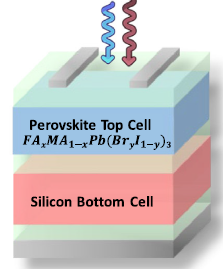Impact of mixed perovskite composition based silicon tandem PV devices on efficiency limits and global performance
Ahmer A.B. Baloch, Omar Albadwawi, Badreyya AlShehhi, Vivian Alberts,
Energy Reports, Volume 8, Supplement 16, 2022,
ISSN 2352-4847,
https://doi.org/10.1016/j.egyr.2022.10.215
What is the worldwide performance of silicon/perovskite solar cells compared to the respective single-junctions?
That is the question that the group of Vivian Alberts from the Research and Development Center of the Dubai Electricity and Water Authority answered by simulating the energy yield and cell temperature depending on the geographical location.
Considering a perovskite solar cell with a bandgap of 1.7eV, tandem cells generate on average 26.7% more energy than silicon solar cells, while dissipating less heat thanks to the higher electrical efficiency. The optimal latitude for tandem performance in the 45◦N to 45◦S range.
With the simulation software Setfos from Fluxim AG they could estimate the theoretical efficiency limit of the tandem device under standard testing conditions (STC) using detailed balance analysis.

